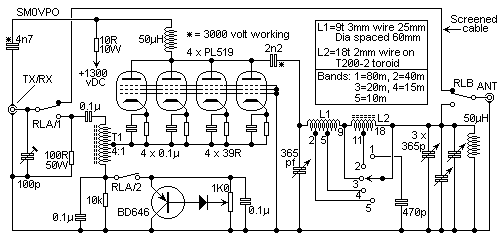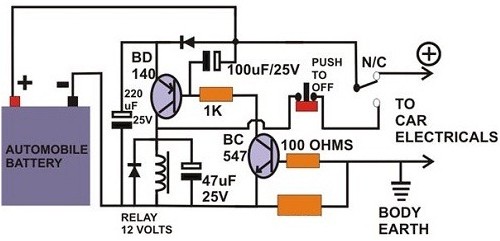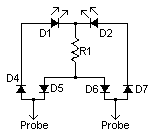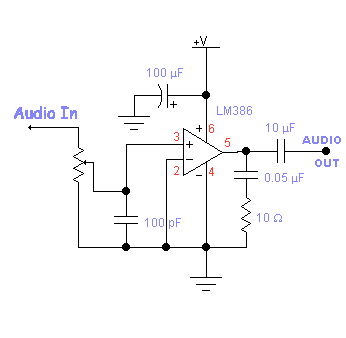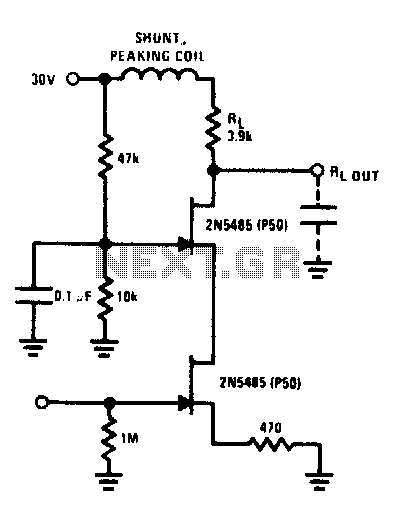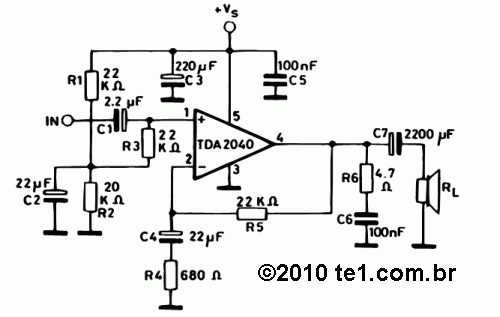
Simple Hybrid Audio Amplifier

The ongoing debate regarding the superiority of valves versus transistors is not the focus here. However, for those undecided, this simple amplifier serves as an excellent test. It employs a valve as a pre-amplifier and a MOSFET in the output stage. The design incorporates strong negative feedback, resulting in an exceptionally flat frequency response. In the prototype, alternative components were tested; for instance, the BUZ11 can be substituted with an IRFZ34N, and an ECC83 can replace the ECC88, necessitating a slight reduction in anode voltage to 155 V. The ECC83 (also known as the 12AX7 in the US) requires a filament supply of 2 x 6.3 V, and there is no screen between the two triodes, which is typically connected to pin 9. In this setup, pin 9 is connected to the common point of the two filaments, which are grounded through resistor R5. For maintaining audio quality, MKT types are recommended for coupling capacitors C1, C4, and C7, while MKP capacitors are preferable. Capacitor C8 should be an audio-grade electrolytic from Panasonic. Potentiometer P1 adjusts the amount of negative feedback; increasing this feedback flattens the frequency response at the expense of overall gain. Potentiometer P2 sets the quiescent current through T2, with a chosen value of 1.3 A, allowing the output stage to operate in Class A mode, which generates significant heat, necessitating a large heatsink for T2 with a thermal coefficient of 1 K/W or better. Inductor L1 consists of two secondary windings in series from a 2x18V/225 VA toroidal transformer, yielding an inductance of 150 mH, which exceeds the recommended 50 mH. However, the amplifier struggled to reproduce signals below 160 Hz, with distortion reaching 9% at 20 Hz for a 100 mW signal. To effectively reproduce low-frequency signals, a larger coil with an iron core and air gap is required to prevent saturation under high DC currents. Such cores can be salvaged from obsolete equipment, like old video recorders, consisting of welded E and I sections. These transformers can be adapted into the required inductor by cutting through the weld, removing the windings, and adding 250 to 300 turns of 0.8 mm enamelled copper wire, ensuring the E and I sections are reassembled with paper insulation. The circuit design encourages experimentation, although managing multiple supply voltages can be challenging. To address this, a dedicated power supply was designed for the amplifier, which can also be utilized with other amplifiers. This supply features a cascade stage that outputs an unstabilised voltage of 170 V for the SRPP stage (V1). Initial measurements indicated that ripple from this supply caused significant hum in the amplifier output. To mitigate this, a separate high-voltage regulator with short-circuit protection was developed. If a separate transformer is used for the filament supply, it is possible to test the circuit without R5. During testing, a DC voltage was employed for the filament supply. Despite initial reservations, the amplifier performs admirably, surpassing many consumer amplifiers in sound quality. While output power is limited, it remains sufficient for enjoyable listening experiences. For increased power, using multiple MOSFETs in the output stage is advisable, alongside reinforcing the inductor.
The amplifier circuit described combines the benefits of both valve and solid-state technologies, resulting in a hybrid amplifier that offers unique audio characteristics. The use of a valve in the pre-amplifier stage contributes warmth and richness to the sound, while the MOSFET output stage provides efficiency and power handling capabilities. The design emphasizes the importance of feedback in achieving a flat frequency response, which is critical for high-fidelity audio applications.
The choice of components plays a significant role in the performance of the amplifier. The ECC83 valve, known for its low noise and high gain, is a suitable choice for the pre-amplifier stage, while the MOSFET's ability to handle high currents makes it ideal for the output stage. The careful selection of coupling capacitors ensures minimal signal degradation, preserving audio quality.
Thermal management is a critical consideration in this design, particularly due to the Class A operation of the output stage, which results in higher power dissipation. The recommended heatsink specifications ensure that the MOSFET operates within safe temperature limits, thus enhancing reliability and longevity.
The inductor design is crucial for low-frequency performance. By utilizing an iron core with an air gap, the circuit can effectively handle large DC currents without saturation, which is essential for accurate bass reproduction. The modification process for the transformer into an inductor illustrates the adaptability of the design and encourages users to engage in hands-on experimentation.
Overall, this amplifier circuit serves as a compelling project for electronics enthusiasts, offering opportunities for customization and improvement while delivering high-quality audio performance.The debate still goes on as to which are better, valves or transistors. We don`t intend to get involved in that argument here. But if you can`t make your mind up, you should try out this simple amplifier. This amplifier uses a valve as a pre-amplifier and a MOSFET in the output stage. The strong negative feedback makes the frequency response as fl at as a pancake. In the prototype of the amplifier we`ve also tried a few alternative components. For example, the BUZ11 can be replaced by an IRFZ34N and an ECC83 can be used instead of the ECC88. In that case the anode voltage should be reduced slightly to 155 V. The ECC83 (or its US equivalent the 12AX7) requires 2 x 6. 3 V for the filament supply and there is no screen between the two triodes, normally connected to pin 9. This pin is now connected to the common of the two filaments. The filaments are connected to ground via R5. If you`re keeping an eye on the quality, you should at least use MKT types for coupling capacitors C1, C4 and C7.
Better still are MKP capacitors. For C8 you should have a look at Panasonic`s range of audio grade electrolytics. P1 is used to set the amount of negative feedback. The larger the negative feedback is, the flatter the frequency response will be, but the smaller the overall gain becomes. With P2 you can set the quiescent current through T2. We have chosen a fairly high current of 1. 3 A, making the output stage work in Class A mode. This does generate a relatively large amount of heat, so you should use a large heatsink for T2 with a thermal coefficient of 1 K/W or better.
For L1 we connected two secondary windings in series from a 2x18V/225 VA toroidal transformer. The resulting inductance of 150 mH was quite a bit more than the recommended 50 mH. However, with an output power of 1 W the amplifier had difficulty reproducing signals below 160 Hz. The distortion rose to as much as 9% for a signal of 20 Hz at 100 mW. To properly reproduce low-frequency signals the amplifier needs a much larger coil with an iron core and an air gap. This prevents the core from saturating when a large DC current flows through the coil. Such a core may be found in obsolete equipment, such as old video recorders. A suitable core consists of welded E and I sections. These transformers can be converted to the required inductor as follows: cut through the welding, remove the windings, add 250 to 300 windings of 0.
8 mm enamelled copper wire, firmly fix the E and I sections back together with a piece of paper in between as isolation. The concepts used in this circuit lend themselves very well to some experimentation. The number of supply voltages can be a bit of a problem to start with. For this reason we have designed a power supply especially for use with this amplifier (Quad power supply for hybrid amp).
This can of course just as easily be used with other amplifiers. The supply uses a cascade stage to output an unstabilised voltage of 170 V for the SRPP (single rail push pull) stage (V1). During initial measurements we found that the ripple on this supply was responsible for a severe hum at the output of the amplifier.
To get round this problem we designed a separate voltage regulator (High-voltage regulator with short circuit protection), which can cope with these high voltages. If you use a separate transformer for the filament supply you can try and see if the circuit works without R5.
During the testing we used a DC voltage for the filament supply. Although you may not suspect it from the test measurements (see table), this amplifier doesn`t sound bad. In fact, it is easily better than many consumer amplifiers. The output power is fairly limited, but is still enough to let your neighbours enjoy the music as well.
It is possible to make the amplifier more powerful, in which case we recommend that you use more than one MOSFET in the output stage. The inductor also needs to be made beefier. Since this is 🔗 External reference
The amplifier circuit described combines the benefits of both valve and solid-state technologies, resulting in a hybrid amplifier that offers unique audio characteristics. The use of a valve in the pre-amplifier stage contributes warmth and richness to the sound, while the MOSFET output stage provides efficiency and power handling capabilities. The design emphasizes the importance of feedback in achieving a flat frequency response, which is critical for high-fidelity audio applications.
The choice of components plays a significant role in the performance of the amplifier. The ECC83 valve, known for its low noise and high gain, is a suitable choice for the pre-amplifier stage, while the MOSFET's ability to handle high currents makes it ideal for the output stage. The careful selection of coupling capacitors ensures minimal signal degradation, preserving audio quality.
Thermal management is a critical consideration in this design, particularly due to the Class A operation of the output stage, which results in higher power dissipation. The recommended heatsink specifications ensure that the MOSFET operates within safe temperature limits, thus enhancing reliability and longevity.
The inductor design is crucial for low-frequency performance. By utilizing an iron core with an air gap, the circuit can effectively handle large DC currents without saturation, which is essential for accurate bass reproduction. The modification process for the transformer into an inductor illustrates the adaptability of the design and encourages users to engage in hands-on experimentation.
Overall, this amplifier circuit serves as a compelling project for electronics enthusiasts, offering opportunities for customization and improvement while delivering high-quality audio performance.The debate still goes on as to which are better, valves or transistors. We don`t intend to get involved in that argument here. But if you can`t make your mind up, you should try out this simple amplifier. This amplifier uses a valve as a pre-amplifier and a MOSFET in the output stage. The strong negative feedback makes the frequency response as fl at as a pancake. In the prototype of the amplifier we`ve also tried a few alternative components. For example, the BUZ11 can be replaced by an IRFZ34N and an ECC83 can be used instead of the ECC88. In that case the anode voltage should be reduced slightly to 155 V. The ECC83 (or its US equivalent the 12AX7) requires 2 x 6. 3 V for the filament supply and there is no screen between the two triodes, normally connected to pin 9. This pin is now connected to the common of the two filaments. The filaments are connected to ground via R5. If you`re keeping an eye on the quality, you should at least use MKT types for coupling capacitors C1, C4 and C7.
Better still are MKP capacitors. For C8 you should have a look at Panasonic`s range of audio grade electrolytics. P1 is used to set the amount of negative feedback. The larger the negative feedback is, the flatter the frequency response will be, but the smaller the overall gain becomes. With P2 you can set the quiescent current through T2. We have chosen a fairly high current of 1. 3 A, making the output stage work in Class A mode. This does generate a relatively large amount of heat, so you should use a large heatsink for T2 with a thermal coefficient of 1 K/W or better.
For L1 we connected two secondary windings in series from a 2x18V/225 VA toroidal transformer. The resulting inductance of 150 mH was quite a bit more than the recommended 50 mH. However, with an output power of 1 W the amplifier had difficulty reproducing signals below 160 Hz. The distortion rose to as much as 9% for a signal of 20 Hz at 100 mW. To properly reproduce low-frequency signals the amplifier needs a much larger coil with an iron core and an air gap. This prevents the core from saturating when a large DC current flows through the coil. Such a core may be found in obsolete equipment, such as old video recorders. A suitable core consists of welded E and I sections. These transformers can be converted to the required inductor as follows: cut through the welding, remove the windings, add 250 to 300 windings of 0.
8 mm enamelled copper wire, firmly fix the E and I sections back together with a piece of paper in between as isolation. The concepts used in this circuit lend themselves very well to some experimentation. The number of supply voltages can be a bit of a problem to start with. For this reason we have designed a power supply especially for use with this amplifier (Quad power supply for hybrid amp).
This can of course just as easily be used with other amplifiers. The supply uses a cascade stage to output an unstabilised voltage of 170 V for the SRPP (single rail push pull) stage (V1). During initial measurements we found that the ripple on this supply was responsible for a severe hum at the output of the amplifier.
To get round this problem we designed a separate voltage regulator (High-voltage regulator with short circuit protection), which can cope with these high voltages. If you use a separate transformer for the filament supply you can try and see if the circuit works without R5.
During the testing we used a DC voltage for the filament supply. Although you may not suspect it from the test measurements (see table), this amplifier doesn`t sound bad. In fact, it is easily better than many consumer amplifiers. The output power is fairly limited, but is still enough to let your neighbours enjoy the music as well.
It is possible to make the amplifier more powerful, in which case we recommend that you use more than one MOSFET in the output stage. The inductor also needs to be made beefier. Since this is 🔗 External reference
